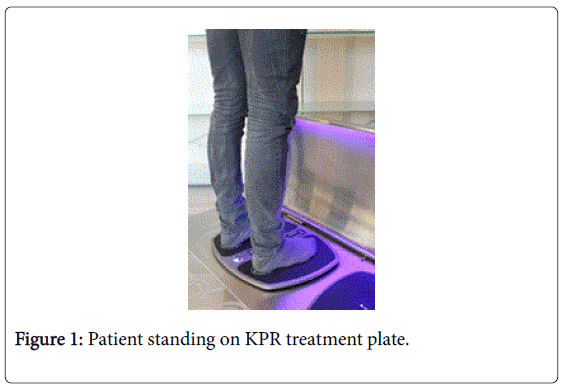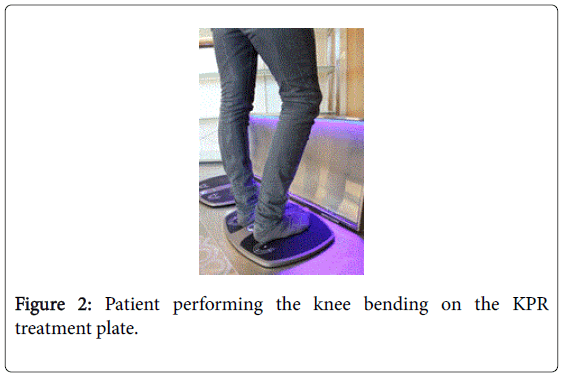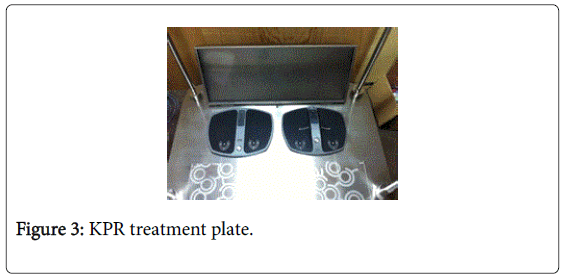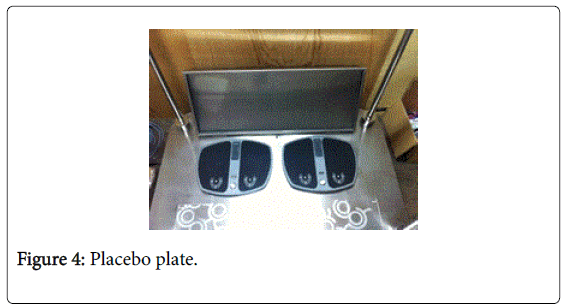Reduction of Iliac Crest Height Difference After Intervention with the Krullaards Perfect Reset Treatment Plate in Patients with Chronic Non- Specific Low Back Pain: A Randomized Controlled Trial
Received: 02-May-2018 / Accepted Date: 14-May-2018 / Published Date: 15-May-2018 DOI: 10.4172/2165-7025.1000391
Abstract
Background: Nonspecific low back pain is the most common disease in the Netherlands and has a prevalence of over 2.500.000 patients. The last decade, vibration plates are evaluated as influencing muscle tuning and soft tissues of the lumbar spine. The Krullaards Perfect Reset (KPR) plate as treatment plate with vibration function has not been investigated yet.
Objective: To evaluate if an intervention with the Krullaards Perfect Reset treatment plate (KPR) could decrease iliac crest height difference, as measured using a PALM meter, to a difference smaller than 0.5 centimeters in patients with nonspecific low back pain.
Study design: Double-blind randomized controlled trial
Methods: 26 participants with a non-specific low back pain history were randomly assigned to intervention or control group. Following pre-treatment measurements of anatomic leg length difference (LLD), clinical LLD, iliac crest height and pelvic torsion, participants had to step onto the KPR or a placebo plate. After treatment measurements on clinical LLD, iliac crest height and pelvic torsion were repeated.
Results: Significant results were found for changes in iliac crest height difference after treatment with the KPR vibration plate (0.4 centimetres) and control group comparison (0.7 centimetres), p=0.02. In addition, a large effect size of 0.85 was seen in favour of the intervention group. No significant results were found for changes in clinical LLD and pelvic torsion.
Conclusion: This proof of concept study demonstrates a decrease of iliac crest height difference, as measured using a PALM meter, to a difference smaller than 0.5 centimeters in patients with nonspecific low back pain using the KPR treatment plate based on the novel concept of combining vibrations and movement to influence pelvic muscle tuning
Keywords: Low back pain; Posture; Vibration; Leg length inequality
Introduction
Nonspecific low back pain is the most common disease in the Netherlands and has a prevalence of over 2.500.000 patients [1]. It is defined as ‘no demonstrable abnormalities and an episode of symptoms, such as pain in the lumbosacral area, upper leg or pain in daily activities like sitting or lifting, lasting three months or over [2]. Health care costs for low back pain were estimated at 337.3 million Euros in 2005 which amounted 0.9% of the total health care costs [1].
Pelvic dysfunction is hypothesized as a cause of nonspecific low back pain [3]. An asymmetric pelvic position, anterior and/or posterior tilt, may cause low back pain by increased loading on the lumbar spine in daily activities such as sitting or bending [4,5]. Pelvis, sacrum, spine and legs are functionally interrelated through muscles, fascia and ligaments and must be analyzed as a chain [6,7]. Anterior pelvic tilt is linked to a motor control problem and core stability and core strength deficiency [8]. Therefore, to measure the angle between the bony landmarks ASIS and PSIS can be used to determine muscle strength balance [8].
Clinical leg length difference (LLD) is a diagnostic value for pelvic malalignment. In case of clinical LLD, the anterior superior illiac spina to medial malleolus distance will differ between both legs. In supine position, in case of unilateral anterior pelvic shift the sacral base will level itself and the pelvis will be lower on the effected side. This phenomenon will cause a clinical leg length difference of about 1 to 1.5 centimeters to detriment of the effected side [3].
Recently, a new type of treatment plate, the Krullaards Perfect Reset plate therapy (KPR), was introduced in the Netherlands. It was developed to restore the asymmetry resulting in iliac crest height difference smaller than 0.5 centimeters and a reset of neuromuscular input of tensed muscles by using the impact of the muscle tuning strategy using low impact vibrations in combination with blue light and sound impulses. Although it was hypothesized that light and sound could influence the autonomous nervous system, no literature was found to underpin this part of the treatment. In daily practice, one intervention and two follow-up interventions are used in combination with KPR inlays for an effect of the therapy.
This device, must be scientifically evaluated and proven solid before use in regular clinical practice will be possible in patients with nonspecific low back pain.
Therefore, the aim of this proof of concept study was to evaluate if an intervention with the KPR could decrease iliac crest height difference, as measured using a PALM meter, to a difference smaller than 0.5 centimeters in patients with nonspecific low back pain.
Methods
The study design was a randomized controlled trial, carried out in collaboration with S center Evers in Barneveld, the Netherlands in June 2016. All participants were recruited in the neighborhood of Barneveld using flyers and online advertisement. The trial was approved by the medical ethics committee of Utrecht by file number 16-008.
Population
Inclusion and exclusion criteria are presented in Table 1. All participants were informed using an information letter and had to give their informed consent before the start of the study.
| Inclusion criteria | Exclusion criteria |
|---|---|
| 18-60 years old | Demonstrable cause of low back pain |
| Episode of low back >3 months | Physical therapy or drug intervention during study period and previous month |
| Illiac crest height difference of >0.5 centimeters at first measurement | Not able to read and speak Dutch |
| Anatomical LLD* of >0.5 centimeters | |
| ASIS**, PSIS*** and trochanter major not palpable due to heavy obesity | |
| Pregnancy | |
| Acute thrombosis |
*leg length difference, **anterior superior iliac spina, ***posterior superior illac spina
Table 1: Inclusion and exclusion criteria.
Intervention
The Krullaards Perfect Reset plate (KPR) was used to reset the pelvic position by using a specific combination of sensory input by low frequency whole body vibrations, 30-50 hz, movement of the participants, and sound and light impulses (Figures 1-3).
At first, the participant had to step onto the device which was situated on the left side of the KPR plate, the heels placed on the marks, to analyze if the patient was able to carry his weight on both legs.
Second, the participant had to step onto the device which was situated on the right side of the plate (Figure 1). The medial side of the feet placed against the curve, looking forward and arms hanging relaxed. The researcher instructed the participants to bend the left knee and keeping the right knee stretched and move on to stretch the left knee and bend the right knee (Figure 2). This was repeated ten times.
Placebo
The placebo KPR treatment followed the same procedure as the KPR treatment. The difference was that the plate, which was located in the same room, had no curved surface on the device at the right and did not provide vibrations, but it produced the same light and audio signals as the KPR plate did (Figure 4).
Measurement instruments
The PALpationMeter (PALM) was used as main outcome measure in this study because it was used in daily practice of the KPR vibration plate. No evidence is found on using a PALM for iliac crest height difference in centimeters. Therefore, clinical leg LLD and pelvic torsion were measured to underpin the results [9-13].
Procedure
Prior to the intervention, all participants completed a questionnaire on baseline characteristics such as age, low back pain history and prior interventions. After inclusion, participants were randomly divided into two groups, intervention and placebo, by using http://www.randomizer.org.
The measurements presented in Table 2 were executed by an experienced physical therapist before and after intervention.
| Measurement | Reference points | Device | Outcome |
|---|---|---|---|
| Illiac crest height | Crista illiaca left and right | PALpationMeter | In centimeters difference |
| Pelvic torsion | ASIS and PSIS both left and right | PALpationMeter | Angle difference/anterior or dorsal torsion |
| Anatomical LLD* | Trochanter major – lateral malleolus | Tape measure | In centimeters left and right leg |
| Clinical LLD | ASIS – medial malleolus | Tape measure | In centimeters left and right leg |
Table 2: Data collection.
After the before measurement, the physical therapist left the room before the intervention-physical therapist entered the room. After the intervention, the participant was asked to step onto the markers placed on the floor between the intervention and placebo plate, and the intervention-physical therapist left the room. The first physical therapist was asked to enter the room again to complete the measurements after intervention.
Statistical Analyses
SPSS version 24.0 was used to analyze the data, using a two-sided alpha 0.5 level of significance for all statistical tests. Descriptive statistics were used to describe participants’ characteristics and history of nonspecific low back pain.
An independent samples t-test or non-parametric equivalent was used to analyze changes iliac crest height difference, clinical LLD and pelvic torsion difference after intervention or placebo between intervention and control group.
Sample size was calculated on the independent sample’s t-test and based on an iliac crest height average of 1.4 cm for group 1 and 0.9 cm for group 2 with a standard deviation of 0.6 cm. The smallest clinically important difference was 0.5 cm. Both groups included 20 patients using an α of 0.05 and a β of 0.90. With an addition of 25% surplus for lost to follow-up, the total sample size was 50 participants. Each group, treatment and placebo, had 25 participants.
Results
A total of 54 participants were recruited for study participation based on the questionnaire and were randomly assigned to intervention or placebo treatment. 28 participants were excluded due to iliac crest height difference of <0.5 cm (20) or anatomic LLD of >0.5 cm [8]. 12 participants in the intervention group and 14 in the placebo group were eligible to complete the procedure. Post hoc power analysis showed a standard deviation of 0.4 cm. So, after recalculation for a two-sided α of 0.05 and a β of 0.87 now 26 patients were needed.
Baseline characteristics of all participants are presented in Table 3. Women and men were not equally distributed over both the intervention and control group. Participants in the intervention group had a longer episode of low back pain compared to the control group but both groups had met the criteria of 3 months.
| Intervention group (n=12) mean, SD/% |
Control group (n=14) mean, SD/% |
|
|---|---|---|
| Gender, % women | 66.7 % (n=8) | 35.7% (n=5) |
| Age (years), SD | 43.1 ± 3.5 | 40.6 ± 2.9 |
| Low back pain (months), SD | 103.7 ± 18.1 | 62.43 ± 12.1 |
| Intervention, %: | ||
| - No intervention | 58.30% | 71.40% |
| - exercises | 0% | 0% |
| - manipulation | 8.30% | 0% |
| - massage & exercises | 0% | 21.40% |
| - massage & manipulation | 16.70% | 0% |
| - manipulation & exercises | 16.70% | 7.10% |
| Medication, %: | ||
| - no medication | 83.30% | 92.90% |
| - Paracetamol | 8.30% | 7.10% |
| - Morphine | 0% | 0% |
| - Diclofenac | 8.30% | 0% |
| - Tramadol | 0% | 0% |
| Inlays, % yes | 41.7% (n=5) | 42.9% (n=6) |
| Anatomic LLD (centimetres), SD | 0.18 ± 0.04 | 0.14 ± 0.04 |
| Iliac crest height difference (centimetres), SD | 1.017 ± 0.104 | 0.914 ± 0.118 |
Table 3: Baseline characteristics.
Both intervention and control group showed a substantial reduction of the mean iliac crest height difference, in the intervention group a reduction of 0.7 cm to a value of 0.3 cm versus 0.4 cm to 0.6 cm in the control group: a significant difference (p=0.02). The effect size of the KPR treatment plate was 0.85, a large effect. Pelvic torsion decreased in both groups, but the most in the control group. Clinical LLD was not relevantly influenced in both groups. Results are presented in Table 4.
| Intervention group changes in mean difference, SD |
Control group changes in mean difference, SD |
Between groups independent samples t-test, p-value |
|
|---|---|---|---|
| Iliac crest height | -0.700 ± 0.298 | -0.357 ± 0.403 | p=0.02 |
| Clinical LLD | -0.150 ± 0.412 | -0.036 ± 0.253 | p=0.42 |
| Pelvic torsion | -0.151 ± 1.740 | -0.371 ± 0.412 | p=0.33 |
Table 4: Results.
Discussion
This randomized controlled trial, a proof of concept study, evaluated the effect of the Krullaards Perfect Reset plate on the iliac crest height difference in patients with non-specific low back pain. Statistically significant differences between intervention and control group were found for changes in mean iliac crest height difference (p=0.02) in favour of the intervention group with a large effect size of 0.85. Hereby, the study could confirm the results of the KPR pilot studies (unpublished data), in which the KPR showed good results in reducing iliac crest height difference to a number below 0.5 centimetres and reducing low back pain measured with a NRS for pain.
Both the intervention and control group showed a decrease in iliac crest height difference. This effect may be caused by the knee movements all the participants had to perform and the positive influence of moving on muscle tuning [6-8]. The fact is that the intervention group iliac crest height decreased to a level below 0.5 centimetres, 0.3 centimetres, which is seen as a restoration of pelvic muscle balance due to the vibration effects of the KPR intervention plate. The last decade, scientific research has increased on whole body low impact vibrations as a treatment for low back pain. It is hypothesized that vibrations plates are able to influence the muscle tuning by impact on the soft tissues [14]. The magnitude of the muscular response is related to the interaction between the frequency and amplitude of the vibrations and the intrinsic neuromuscular properties. Low frequency vibrations can increase the enhancement of the pelvic position in squatting position by using the proprioceptive system compared to controls without the vibration input [15,16].
Unfortunately, not all the participants fulfilled all of the inclusion criteria. This flaw was caused by the fact that in deviation from the research protocol not every participant was measured for iliac crest height difference before inclusion due to lack of time. Inclusion was only based on low back pain history in these participants. This was noticed as late as the phase of analysis, after completion of the measurements.
Also, in this research protocol, both the intervention and placebo group were instructed to make ten knee movements on the plate. In daily practice, knee movements are made until the physical therapist measures an iliac crest height difference of 0 or within 0.5 centimetres differences with the PALM. Ten knee movements may be to less to create an optimal effect for the intervention group, potentially reducing the current effect size. For future research the amount of knee bends should be based on the highest amount of repetitions used in the pilot data.
Above all, both the intervention and placebo plate showed the same light and audio signals. Influence of light and audio signals on the autonomous nervous system is still unknown, but the developers of the KPR hypothesize these to influence muscle tension. If true, the audio and light signals may have caused an effect in both groups, diminishing the distinction between the purported intervention and the purported placebo treatment.
In literature, various treatments for nonspecific low back pain are present. Manipulative therapy and mobilization were discussed in a review by Bronfort et al. [17] based on patient rated outcomes and pain levels. Moderate effects were shown compared to NSAID and physical therapy in both short and long term releave in favour of manipulative therapy [17,18]. In a Cochrane review, Hayden et al. discussed exercise therapy in patients with chronic low back pain. After a short follow-up, individually delivered strengthening and trunk stabilization exercises were shown more effective than comparison (conservative) treatment, like massage [19]. Furthermore, slight improvement can be shown in pain levels and function in daily activities [20]. The same results were found by Van Middelkoop et al. [21]. Furthermore, no exercise based intervention scored better results than one another, taken duration and intensity into account.
The KPR treatment plate is filling the niece between exercise based intervention and vibration therapy. The treatment plate is designed for patients with non-specific low back pain, not responding to exercise therapy, manual therapy or NSAIDS on the longer term. Intrinsic neuromuscular properties are activated by the low frequency vibration system of the treatment plate to reduce pain symptoms, while optimum muscle tuning is reached by the proprioceptive response to movement and light and audio signals influencing the autonomous nervous system.
Conclusion
This proof of concept study demonstrates a decrease of iliac crest height difference, as measured using a PALM meter, to a difference smaller than 0.5 centimeters in patients with nonspecific low back pain using the KPR treatment plate based on the novel concept of combining vibrations and movement to influence pelvic muscle tuning.
Future in depth research should focus on the total treatment procedure in clinical practice, containing three interventions and inlays to remain a balanced pelvic position and active muscle tuning during daily activities. Outcomes should be measured using iliac crest height difference, as well as patient reported outcome measures on daily activities and low back pain symptoms.
References
- HSJ P (2005) Aspecifieke lage rugklachten: omgang en gevolgen. Centrum voor Preventie en Zorgonderzoek, RIVM.
- Staal JB HE, Heijmans M, Kiers H, Lutgers-Boomsma AM, Rutten G, et al. (2003) KNGF-Richtlijn Lage Rugpijn. Online publication Royal Dutch Federation for Physical Therapy.
- DonTigny RL (1985) Function and pathomechanics of the sacroiliac joint. A review. Phys Ther 65: 35-44.
- Jull GA JV (1987) Muscles and motor control in lower back pain: Assessment and management. Physical Therapy of the Lower Back (1st edn) Churchill Livingstone: New York.
- Levine D, Whittle MW (1996) The effects of pelvic movement on lumbar lordosis in the standing position. J Orthop Sports Phys Ther 24: 130-135.
- Vleeming A, Schuenke MD, Masi AT, Carreiro JE, Danneels L, et al. (2012) The sacroiliac joint: an overview of its anatomy, function and potential clinical implications. J Anat 221: 537-567.
- Vora AJ, Doerr KD, Wolfer LR (2010) Functional anatomy and pathophysiology of axial low back pain: disc, posterior elements, sacroiliac joint, and associated pain generators. Phys Med Rehabil Clin N Am 2: 679-709.
- Willson JD, Dougherty CP, Ireland ML, Davis IM (2005) Core stability and its relationship to lower extremity function and injury. J Am Acad Orthop Surg 13: 316-325.
- Azevedo DC, Santos H, Carneiro RL, Andrade GT (2014) Reliability of sagittal pelvic position assessments in standing, sitting and during hip flexion using palpation meter. J Bodyw Mov Ther 18: 210-214.
- Betsch M, Schneppendahl J, Dor L, Jungbluth P, Grassmann JP, et al. (2011) Influence of foot positions on the spine and pelvis. Arthritis Care Res (Hoboken) 63: 1758-1765.
- Petrone MR, Guinn J, Reddin A, Sutlive TG, Flynn TW, et al. (2003) The accuracy of the Palpation Meter (PALM) for measuring pelvic crest height difference and leg length discrepancy. J Orthop Sports Phys Ther 33: 319-325.
- Preece SJ, Willan P, Nester CJ, Graham-Smith P, Herrington L, et al. (2008) Variation in pelvic morphology may prevent the identification of anterior pelvic tilt. J Man Manip Ther 16: 113-117.
- Neelly K, Wallmann HW, Backus CJ (2013) Validity of measuring leg length with a tape measure compared to a computed tomography scan. Physiother Theory Pract 29: 487-492.
- Cardinale M, Wakeling J (2005) Whole body vibration exercise: are vibrations good for you? Br J Sports Med 39: 585-589.
- Fontana TL, Richardson CA, Stanton WR (2005) The effect of weight-bearing exercise with low frequency, whole body vibration on lumbosacral proprioception: a pilot study on normal subjects. Aust J Physiother 51: 259-263.
- Kim JH, Seo HJ (2015) Influence of pelvic position and vibration frequency on muscle activation during whole body vibration in quiet standing. J Phys Ther Sci 27: 1055-1058.
- Bronfort G, Haas M, Evans RL, Bouter LM (2004) Efficacy of spinal manipulation and mobilization for low back pain and neck pain: a systematic review and best evidence synthesis. Spine J 4: 335-356.
- Bronfort G, Goldsmith CH, Nelson CF, Boline PD, Anderson AV (1996) Trunk exercise combined with spinal manipulative or NSAID therapy for chronic low back pain: a randomized, observer-blinded clinical trial. J Manipulative Physiol Ther 19: 570-582.
- Hemmila HM, Keinanen-Kiukaanniemi SM, Levoska S, Puska P (2002) Long-term effectiveness of bone-setting, light exercise therapy, and physiotherapy for prolonged back pain: a randomized controlled trial. J Manipulative Physiol Ther 25: 99-104.
- Hayden JA, van Tulder MW, Malmivaara AV, Koes BW (2005) Meta-analysis: exercise therapy for nonspecific low back pain. Ann Intern Med 142: 765-775.
- van Middelkoop M, Rubinstein SM, Verhagen AP, Ostelo RW, Koes BW, et al. (2010) Exercise therapy for chronic nonspecific low-back pain. Best Pract Res Clin Rheumatol 24: 193-204.
Citation: Polman KJ, Meijer R (2018) Reduction of Iliac Crest Height Difference After Intervention with the Krullaards Perfect Reset Treatment Plate in Patients with Chronic Non-Specific Low Back Pain: A Randomized Controlled Trial. J Nov Physiother 8: 391. DOI: 10.4172/2165-7025.1000391
Copyright: © 2018 Polman KJ, et al. This is an open-access article distributed under the terms of the Creative Commons Attribution License, which permits unrestricted use, distribution, and reproduction in any medium, provided the original author and source are credited.
Select your language of interest to view the total content in your interested language
Share This Article
Recommended Journals
Open Access Journals
Article Tools
Article Usage
- Total views: 7680
- [From(publication date): 0-2018 - Aug 25, 2025]
- Breakdown by view type
- HTML page views: 6622
- PDF downloads: 1058




